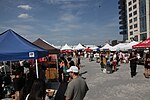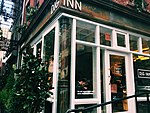Headgear Studio
Headgear Studio (also known as Headgear Recording Studio) was an American recording studio based in Williamsburg, Brooklyn. It was founded in 1998 by Alex Lipsen and Dan Long. In 2000, engineer Scott F. Norton joined as a partner and the studio relocated its facilities near the Brooklyn waterfront. The studio was featured in an article in Tape Op magazine in October, 2008. Headgear first attracted attention when the Yeah Yeah Yeahs recorded their 2003 debut album, Fever to Tell, there with producer David Sitek. That album was nominated for a 2004 Grammy Award for Best Alternative Music Album. Sitek subsequently recorded with his band, TV on the Radio at Headgear and built the adjoining Stay Gold Studio in the same building. According to their Facebook page, the studio closed in 2012.
Excerpt from the Wikipedia article Headgear Studio (License: CC BY-SA 3.0, Authors).Headgear Studio
Wythe Avenue, New York Brooklyn
Geographical coordinates (GPS) Address Phone number Website Nearby Places Show on map
Geographical coordinates (GPS)
| Latitude | Longitude |
|---|---|
| N 40.717745 ° | E -73.962707 ° |
Address
J.Crew
Wythe Avenue 234
11249 New York, Brooklyn
New York, United States
Open on Google Maps






